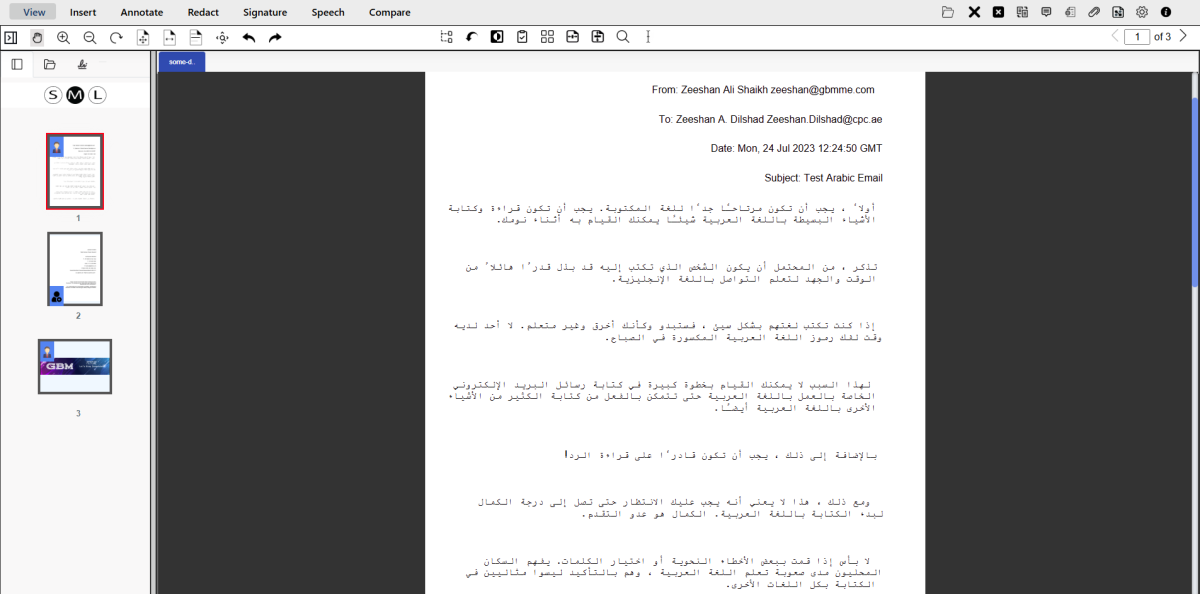The Challenges of Displaying Arabic and Hebrew Text Documents
Published: January 30, 2025
In today’s increasingly interconnected world, document viewers have become a necessary tool for both businesses and individuals. These platforms are used to review contracts, analyze reports, and facilitate seamless access to various types of documents. However, when it comes to displaying languages with complex scripts such as Arabic and Hebrew, many document viewers cannot correctly display these types of documents.
In this blog post, we will discuss the challenges faced by applications like IBM Daeja while rendering Arabic and Hebrew text documents. We will also explore how eViewer document viewer can be a potential solution for these issues.
The Complexity of Arabic and Hebrew Scripts
Displaying Arabic and Hebrew text documents in a document viewer is challenging due to their right-to-left (RTL) script direction, complex character shaping, and bidirectional text nature. It is crucial to ensure proper alignment, font support, and text rendering while accommodating RTL scripts to maintain readability specialized algorithms are needed. Additionally, Arabic and Hebrew scripts require specific ligatures texts, where two or more letters are joined to form a single glyph and diacritics marks, all of which contribute to the complexity of rendering these languages accurately in digital formats.
Document viewers must overcome these challenges to guarantee accurate rendering and user-friendly interfaces for Arabic and Hebrew users, respecting the complexity of their languages and scripts within digital environments.
Challenges Faced by IBM Daeja while Rendering These Documents
Script Directionality: One of the primary challenges faced by document viewers such as IBM Daeja is the handling of text directionality. Unlike left-to-right scripts, Arabic and Hebrew text must be displayed from right to left, which disrupts the layout and formatting of documents.
Ligature Texts and Diacritics Marks: Arabic and Hebrew scripts rely on ligature text and diacritics marks to accurately convey words, meanings, and pronunciation. Therefore, document viewers must be able to handle these complex textual elements seamlessly. Unfortunately, many applications struggle to render ligature texts and diacritics marks correctly, which leads to readability problems and potential misinterpretations of the text.
Character Encoding: Arabic and Hebrew characters often require specific Unicode encoding to ensure proper display across different devices and platforms. Incompatibilities in character encoding result in jumbled text and/or missing characters, further complicating document usability when rendering with certain document viewers.
How eViewer is successful
In contrast to its counterparts, eViewer document viewer stands out for its robust support of Arabic and Hebrew text documents. Here’s why:
Bi-Directional Text Support: eViewer seamlessly accommodates the right-to-left orientation of Arabic and Hebrew scripts ensuring proper alignment, font support, and textual content is displayed accurately, efficiently, and seamlessly on any device.
Unicode Compatibility: eViewer is designed to support a wide range of Unicode fonts ensuring rendering for special bidirectional multi-byte characters.
Font and Formatting Support: eViewer supports handling of document formatting such as managing spacing between words and characters. It even supports formatting within complex content such as tables, images, and other complex textual elements. Additionally, eViewer supports both true type and non-true type Unicode fonts, which ensures seamless handling of Arabic and Hebrew text documents.
Conclusion
Addressing the challenges associated with displaying Arabic and Hebrew text documents becomes paramount. While applications like IBM Daeja struggle with rendering complexities inherent to these languages, eViewer emerges as a reliable solution that prioritizes accuracy, readability, and user experience. By incorporating rendering techniques and robust text-handling capabilities, eViewer sets a new standard for seamlessly displaying Arabic and Hebrew text documents in the digital age.

